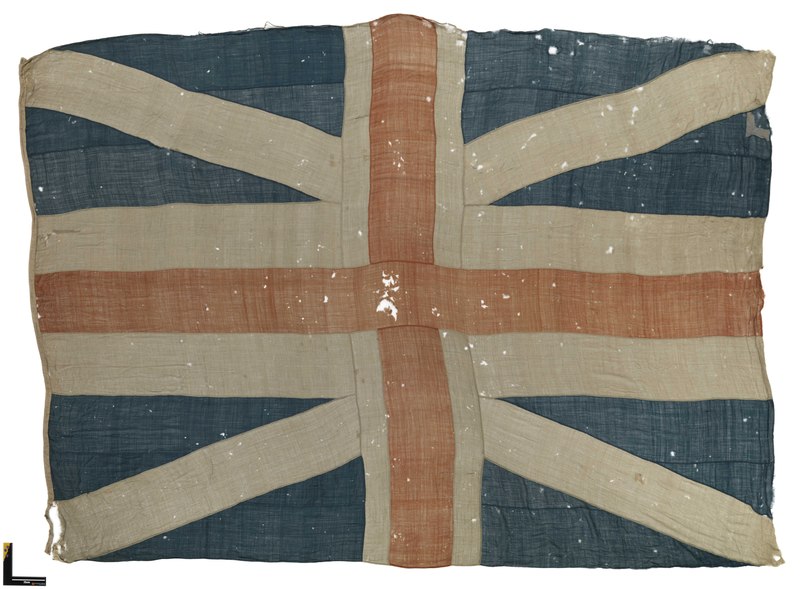File:Command flag, Admiral of the Fleet, RN (before 1801) RMG F7985-001.tiff

Original file (7,368 × 5,424 pixels, file size: 114.34 MB, MIME type: image/tiff)
Captions
Captions
Summary[edit]
| Author |
Unknown authorUnknown author |
| Description |
English: Command flag, Admiral of the Fleet, RN (before 1801) A full-sized command flag of a 1st rate associated with the first fleet action of the French Revolutionary War, fought on the 1 June 1794 and thereafter known as the Glorious 1 June. It was flown as the flag of the British commander, Richard Earl Howe, indicating his role as Admiral of the Fleet. In Philippe-Jacques de Loutherbourg’s painting of the battle (also in the Museum’s collection, see BHC0470), the flag can be seen at the main of Howe’s flagship ‘Queen Charlotte’ forming the apex of the composition. Although the British fleet were the victors capturing six ships and sinking a seventh, the French fleet protected a vital American grain convoy which successfully landed its cargo at a time of food shortage in France. The flag was handed down through the family of a midshipman in ‘Queen Charlotte’, William Burgh, who was promoted lieutenant shortly after the action on the 24 July 1794. Letters from Burgh to his family include an account of the battle and his name is marked on the kitbag in which the flag was kept by his descendents. The construction of the flag is entirely consistent with its provenance — other late 18th and early 19th century flags in the collection show the diagonals of the Scottish saltire failing to join up correctly. The loosely woven bunting and hand-sewn seams are also indicative of an early date. It seems likely that the flag would have been made in the Royal Dockyards or by one of their contractors. James I introduced by royal proclamation in 1606, a flag joining together the crosses and St George and St Andrew, the emblems of his kingdoms of England and Scotland. The king was anxious to unify the two formerly warring states and introduced the name Great Britain for the new dominion. The Union Flag designed by his heralds was specifically for use at sea. It remained in use (with a break during the Commonwealth period) until replaced in 1801 by the present day design. St Patrick’s saltire was added at this date, representing the union of Great Britain and Ireland |
| Date |
before 1794 date QS:P571,+1794-00-00T00:00:00Z/7,P1326,+1794-00-00T00:00:00Z/9 |
| Dimensions | flag: 3962.4 x 5588 mm |
| Notes |
.Rope attached. Flag shown in NMM painting by J P de Loutherbourg. Cord edging round flag. Arrived in canvas kit bag see W1977-106a, Antiquities Equipment Section. RP/32/27-8 do not contain unique number or scale. In archive box: size approx 5-6 long, 30 inches wide, 15 inches deep. |
| Source/Photographer | http://collections.rmg.co.uk/collections/objects/730 |
| Permission (Reusing this file) |
The original artefact or artwork has been assessed as public domain by age, and faithful reproductions of the two dimensional work are also public domain. No permission is required for reuse for any purpose. The text of this image record has been derived from the Royal Museums Greenwich catalogue and image metadata. Individual data and facts such as date, author and title are not copyrightable, but reuse of longer descriptive text from the catalogue may not be considered fair use. Reuse of the text must be attributed to the "National Maritime Museum, Greenwich, London" and a Creative Commons CC-BY-NC-SA-3.0 license may apply if not rewritten. Refer to Royal Museums Greenwich copyright. |
| Other versions |
|
| Identifier InfoField | dossier number: item-union flags id number: AAA0730 |
| Collection InfoField | Textiles |
Licensing[edit]
|
This is a faithful photographic reproduction of a two-dimensional, public domain work of art. The work of art itself is in the public domain for the following reason:
The official position taken by the Wikimedia Foundation is that "faithful reproductions of two-dimensional public domain works of art are public domain".
This photographic reproduction is therefore also considered to be in the public domain in the United States. In other jurisdictions, re-use of this content may be restricted; see Reuse of PD-Art photographs for details. | |||||
File history
Click on a date/time to view the file as it appeared at that time.
| Date/Time | Thumbnail | Dimensions | User | Comment | |
|---|---|---|---|---|---|
| current | 15:54, 14 September 2017 |  | 7,368 × 5,424 (114.34 MB) | Fæ (talk | contribs) | Royal Museums Greenwich Textiles (1794), http://collections.rmg.co.uk/collections/objects/730 #387-1 |
You cannot overwrite this file.
File usage on Commons
The following 3 pages use this file:
Metadata
This file contains additional information such as Exif metadata which may have been added by the digital camera, scanner, or software program used to create or digitize it. If the file has been modified from its original state, some details such as the timestamp may not fully reflect those of the original file. The timestamp is only as accurate as the clock in the camera, and it may be completely wrong.
| Width | 7,368 px |
|---|---|
| Height | 5,424 px |
| Bits per component |
|
| Compression scheme | Uncompressed |
| Pixel composition | RGB |
| Image data location | 140 |
| Number of components | 3 |
| Number of rows per strip | 5,424 |
| Bytes per compressed strip | 119,892,096 |
| Data arrangement | chunky format |

